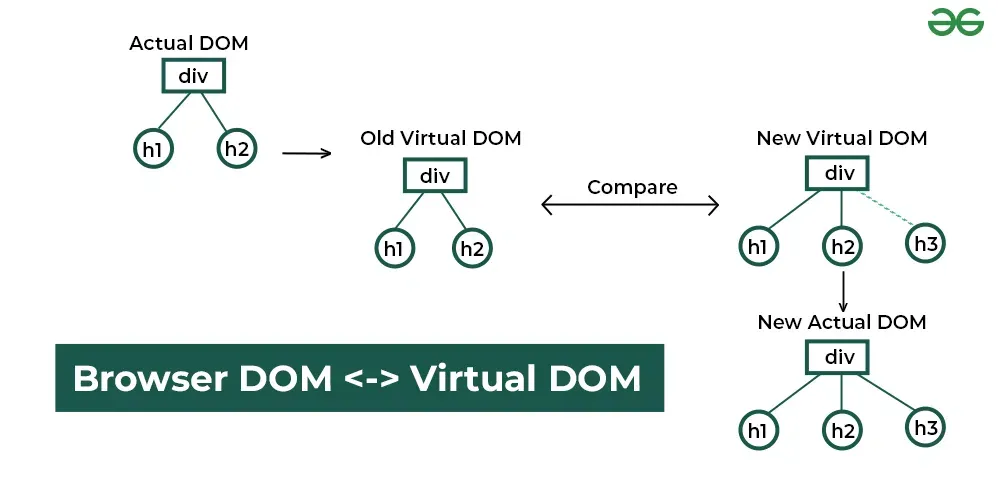React Introduction (original) (raw)
Last Updated : 08 Apr, 2025
ReactJS is a **component-based JavaScript library used to build dynamic and interactive user interfaces. It simplifies the creation of single-page applications (SPAs) with a focus on performance and maintainability.
- It is developed and maintained by Facebook.
- The latest version of React is React 19.
- Uses a virtual DOM for faster updates.
- Supports a declarative approach to designing UI components.
- Ensures better application control with one-way data binding.
“Hello, World!” Program in React
JavaScript `
import React from 'react';
function App() { return (
Hello, World!
export default App;
`
**In this example:
- import React from ‘react’: Imports React to create components and use JSX.
- function App() { … }: Defines a functional component called App.
- return ( … ): Returns JSX that represents the UI (a div with an h1 tag displaying “Hello, World!”).
- export default App: Exports the App component so it can be used elsewhere.

React Introduction
How does React work?
React operates by creating an in-memory virtual DOM rather than directly manipulating the browser’s DOM. It performs necessary manipulations within this virtual representation before applying changes to the actual browser DOM.

How does React woin short simple 1lin zah h
**Here’s how the process works:
**1. Actual DOM and Virtual DOM
- Initially, there is an Actual DOM(Real DOM) containing a div with two child elements: h1 and h2.
- React maintains a previous Virtual DOM to track the UI state before any updates.
**2. Detecting Changes
- When a change occurs (e.g., adding a new h3 element), React generates a New Virtual DOM.
- React compares the previous Virtual DOM with the New Virtual DOM using a process called reconciliation.
**3. Efficient DOM Update
- React identifies the differences (in this case, the new h3 element).
- Instead of updating the entire DOM, React updates only the changed part in the New Actual DOM, making the update process more efficient.
Key Features of React
React is one of the most demanding JavaScript libraries because it is equipped with a ton of features which makes it faster and production-ready. Below are the few features of React.
1. Virtual DOM
React uses a **Virtual DOM to optimize UI rendering. Instead of updating the entire real DOM directly, React:
- Creates a lightweight copy of the DOM (Virtual DOM).
- Compares it with the previous version to detect changes (diffing).
- Updates only the changed parts in the actual DOM (reconciliation), improving performance.
2. Component-Based Architecture
React follows a **component-based approach, where the UI is broken down into reusable components. These components:
- Can be functional or class-based.
- It allows code reusability, maintainability, and scalability.
3. JSX (JavaScript XML)
React uses**JSX, a syntax extension that allows developers to write HTML inside JavaScript. JSX makes the code:
- More readable and expressive.
- Easier to understand and debug.
4. One-Way Data Binding
React uses one-way data binding, meaning data flows in a single direction from parent components to child components via props. This provides better control over data and helps maintain predictable behavior.
5. State Management
React manages component state efficiently using the useState hook (for functional components) or this.state (for class components). State allows dynamic updates without reloading the page.
6. React Hooks
Hooks allow functional components to use state and lifecycle features without needing class components. Common hooks include:
- **useState: for managing local state.
- **useEffect: for handling side effects like API calls.
- **useContext: for global state management.
7. React Router
React provides React Router for managing navigation in single-page applications (SPAs). It enables dynamic routing without requiring full-page reloads.
ReactJS Lifecycle
Every React Component has a lifecycle of its own, the lifecycle of a component can be defined as the series of methods that are invoked in different stages of the component’s existence. React automatically calls these methods at different points in a component’s life cycle. Understanding these phases helps manage the state, perform side effects, and optimize components effectively.
**1. Initialization
This is the stage where the component is constructed with the given Props and default state. This is done in the constructor of a Component Class.
2. Mounting Phase
- **Constructor: The constructor method initializes the component. It’s where you set up the initial state and bind event handlers.
- **render(): This method returns the JSX representation of the component. It’s called during initial rendering and subsequent updates.
- **componentDidMount(): After the component is inserted into the DOM, this method is invoked. Use it for side effects like data fetching or setting timers.
3. Updating Phase
- **componentDidUpdate(prevProps, prevState): Called after the component updates due to new props or state changes. Handle side effects here.
- **shouldComponentUpdate(nextProps, nextState): Determines if the component should re-render. Optimize performance by customizing this method.
- **render(): Again, the render() method reflects changes in state or props during updates.
4. Unmounting Phase
- **componentWillUnmount(): Invoked just before the component is removed from the DOM. Clean up resources (e.g., event listeners, timers).
For More detail read the article – React Lifecycle Methods
Applications of React
- **Web Development: React is used to build dynamic and responsive web applications, including social media platforms, e-commerce sites, and blogs.
- **Mobile Apps: React Native allows developers to build mobile apps for iOS and Android using the same codebase.
- **Enterprise Applications: React is used in building large-scale enterprise applications that require a highly interactive UI.
- **Dashboards and Data Visualizations: React is great for building real-time dashboards and data visualization tools due to its high performance.
Limitations of React
- **SEO Challenges: Since React is a client-side library, SEO optimization can be difficult for pages with heavy dynamic content. However, tools like Next.js can be used to render React applications server-side for better SEO.
- **Steep Learning Curve: React’s ecosystem is vast, and learning how to work with tools like Redux and React Router and understanding component lifecycle methods can be challenging for beginners.
- **Boilerplate Code: Setting up and maintaining state management libraries like Redux or Context API can involve writing boilerplate code, especially for large applications.
React vs Angular
| React | Angular |
|---|---|
| React is a JavaScript library | Angular is a JavaScript framework |
| React uses one-way data binding, | Angular uses two-way data binding |
| React uses JSX (JavaScript XML) for templating. | Angular uses HTML templates with special Angular directives. |
| React uses the Virtual Dom concept | Angular used the Real Dom concept |
History of React
- React was developed by Facebook in 2011 to improve the performance of their applications and was officially released as an open-source library in 2013.
- It was designed to create dynamic, fast, and responsive user interfaces for web applications by focusing on the view layer.
- React introduced concepts like components (reusable UI pieces) and the virtual DOM (a lightweight copy of the real DOM) for optimizing UI updates.
- React is now a widely used framework for building modern web and mobile apps, supported by a strong community and major companies.
For more details Read the article – History and Evolution of React
React: Enhancements and New Features
New Features Added in React 19
- **Server-Side Rendering Improvements: React 19 improves server-side rendering (SSR) performance, allowing web apps to render faster and be more SEO-friendly.
- **React Suspense Advancements: Suspense has been further enhanced, making it easier to manage asynchronous data loading and enabling better UX for handling component rendering while waiting for data.
- **Concurrent Mode: Enhancements to Concurrent Mode allow React apps to remain responsive and smooth, especially during complex updates or when handling large amounts of data.
- **Automatic Batching Enhancements: Automatic Batching improvements provide better performance for asynchronous updates, ensuring that multiple state updates are batched together for improved efficiency.
- Better Integration with Modern Web Standards: React 19 improves integration with the latest web standards like Web Vitals, Intersection Observer, and CSS Grid, enhancing responsiveness and overall performance.
- **New Hooks API: New hooks were introduced to improve state management and lifecycle control, making functional components even more powerful.
Features Removed in React 19
- **Legacy Context API: The old Context API has been deprecated and removed in favor of the new Context API introduced in React 16.3, which is more efficient and easier to use.
- **Deprecated Lifecycle Methods: Certain lifecycle methods, like componentWillMount, componentWillReceiveProps, and componentWillUpdate, have been fully removed, encouraging developers to use getDerivedStateFromProps and componentDidMount instead.
- **React.createClass: The React.createClass method has been removed in React 19, as the class-based components are now replaced with ES6 class syntax, encouraging developers to use modern JavaScript features.
- **ReactDOM Removed: ReactDOM has been removed in React 19. The rendering and DOM manipulation responsibilities have now been directly integrated into the core of React, and ReactDOM.render() is no longer needed. This move simplifies the React API, and developers are now encouraged to use the root API for managing DOM rendering.